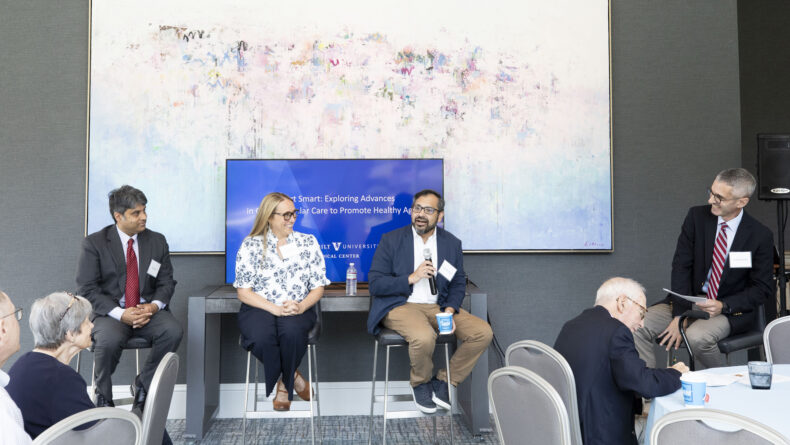
by Nancy Humphrey
More than 300 members of the Canby Robinson Society, the Canby Robinson Legacy Circle and the Vanderbilt University Medical Center community joined Jeff Balser, MD, PhD, and his wife, Melinda, last week at Cheekwood Estate and Gardens for a reception celebrating the community of supporters who help VUMC redefine personalized care.
The year’s program celebrated the Medical Center’s mission and the donors who partner with VUMC to make it possible. The group heard from Balser, President and CEO of VUMC and Dean of Vanderbilt University School of Medicine, and Nancy Brown, MD, professor and chair of Medicine.
The event celebrated the success of VUMC’s transplant program and included moving videos about two VUMC patients — one who donated his organs and the other who received a life-saving heart transplant in October 2017 from a donor infected with hepatitis C — a relatively new occurrence in the field of heart transplant. Elizabeth “Betsy” Barbour of Nashville, a member of the Legacy Circle, also spoke about how a double lung transplant gave her husband five and one-half more quality years of life. She and her family have established an endowment in his name through a gift plan.
“Generosity takes many shapes and forms. Everyone here tonight has generously helped us in ways that are vital to this community,” Balser told the group. “And tonight, we honor our Legacy Circle members . . . These are folks who are making a lasting impact here at VUMC through gifts in their wills or other gift plans.”
The audience viewed a video that went viral this year, of a moving “honor walk” where VUMC staff lined the hallway to honor patient Kyle Fisher, whose family donated his organs upon his death. Balser told the group that Fisher’s gift serves as a reminder of “how one person can impact countless lives, even after his death.”
Balser said that VUMC is not just a place to work. “It’s a place where people feel like family, and like family, they are committed to one another. It’s a big family — 24,000 strong — and that feeling of community at the Medical Center is something patients understand. Because a health care organization that treats everyone at work like family, treats its patients like family. What I also know is that you — our donors, volunteers, community leaders, patients, who generously give us your time and resources — you are core members of that family.”
Brown highlighted the Medical Center’s heart and lung transplant programs.
“One of the amazing things about working at VUMC is the opportunity to bring hope to patients and family when all else may seem hopeless,” she said.
VUMC’s heart transplant program is second in the nation in volume, behind only Cedars-Sinai Medical Center in Los Angeles, with 109 adult and pediatric heart transplants in 2018. In comparison, Cleveland Clinic performed 52 and Mayo Clinic, 24. VUMC’s average survival rates for heart transplant patients are 92% at one year and 82% at three years. Brown and the audience watched a video of heart transplant patient Maurice McAllister, who received a heart from a donor infected with hepatitis C, made possible by innovations in antiviral treatments.
The Medical Center’s lung transplant program is one of the oldest in the nation and the only one in Tennessee. Brown said that VUMC patient Pam Smith, who received a liver transplant in 1990, is the longest-surviving single lung transplant patient in the U.S., celebrating her 29th transplant anniversary this year.
And finally, the group heard from Barbour, whose husband Richard died in 2016 after enjoying an additional five years of quality life.
“There are people here who are much more qualified than I am to tell you about the medical aspects of lung transplant. But they can’t describe the joy you feel hearing your husband breathe without oxygen. They can’t tell you what a joy it is to see him reclaim his own life — to see the color come back into his cheeks, to bathe on his own, to drive himself, to travel, to engage in life again,” she said.
“And if you haven’t had that experience, maybe you don’t understand what a miracle it is. But because of my husband and because of the Vanderbilt lung transplant program, I know that Richard’s transplant will always be the greatest miracle I’ve ever witnessed. And that not even his passing changes that experience.”
The event closed with a song from the United Voices of Vanderbilt choir, a group of talented employees from throughout the Medical Center.

















